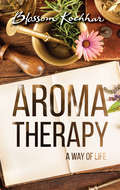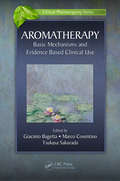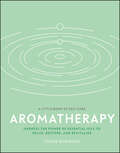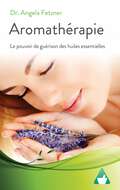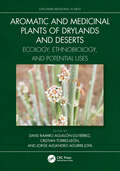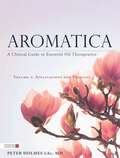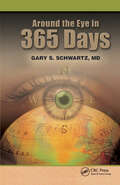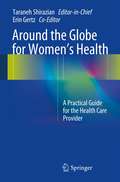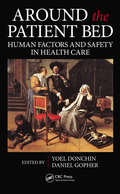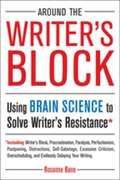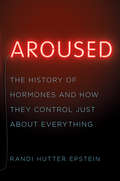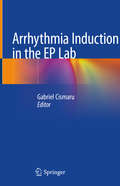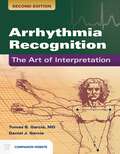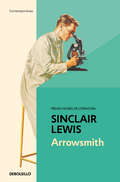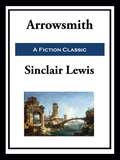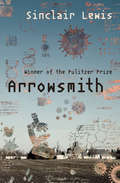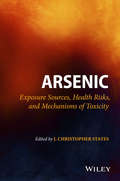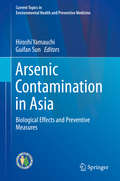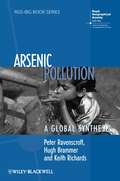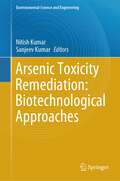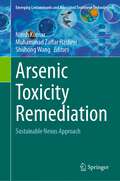- Table View
- List View
Aromatherapy: A Way of Life
by Blossom KochharNature's best-kept secret to give your life the make-over it needs. Is fatigue keeping you from living your best possible life? Is chronic stress spilling over and ruining your relationships? Is self-doubt diminishing your chance of being happy every day? Aromatherapy, which means healing through the sense of smell, is an all-natural targeted solution for the overall well-being of both body and mind. The extraordinary power of essential oils works through your olfactory system to invigorate your senses and restore balance. Dr Blossom Kochhar, in this practical and detailed guide to essential oils, brings forth ways to incorporate nature’s very own essence and opt for an environmental-friendly lifestyle. Be it physiological ailments like pain and exhaustion, or psychological issues like depression and insomnia, essential oils can cure all. Signature blends can even aid in stimulating your love life, adding the spark it may sometimes require. This book is not only a step towards a beautiful, harmonised, and happy life but also walks you through just the right way of achieving it. Tap into nature's pharmacy and utilise the best antidote to everyday problems.
Aromatherapy: Basic Mechanisms and Evidence Based Clinical Use (Clinical Pharmacognosy Series)
by Giacinto Bagetta Marco Cosentino Tsukasa SakuradaThis reference provides an up-to-date compilation of background scientific information that advocates the application of currently developed clinical studies of the effects of aromatherapy to the treatment of human diseases such as mild, stress-induced mood disorders, infectious diseases, and age-related disturbances. It presents a rational basis for clinical translations of aromatherapy for treating human diseases in need of safer or more effective therapies and discusses the need for further clinical development in areas where therapy is lacking.
Aromatherapy: Harness the power of essential oils to relax, restore, and revitalize (A Little Book of Self Care)
by Louise RobinsonMake aromatherapy an indispensable part of your everyday self-care routine with this comprehensive holistic healing guide. If you're in search of a more natural approach to health and wellbeing, expert Louise Robinson has created over 40 bespoke remedies, blends, and rituals to transform your body and mind - the perfect antidote to the stresses of everyday life.Science now supports what practitioners have long known: that oils derived from plants have powerful therapeutic properties, working holistically on mind, body, and spirit. From massage oils to boost immunity, to room diffusers to help you sleep - this book is your complete guide to essential oils and their healing properties. This aromatherapy book takes you on an empowering journey of self-care. It begins by unpacking what aromatherapy and essential oils are, how to use them correctly and how to safely get the most out of them. This reference book is divided into wellbeing treatments designed to uplift the mind, body, and spirit. Also included are healing treatments designed to address, relieve, and help cure a range of common conditions. Your Essential Toolkit For Wellness in The Modern World Aromatherapy is about more than just beautiful smelling aromas that come from essential oils. This carefully curated collection of blends, remedies, and practices shows you how to practice aromatherapy at home. Extract and blend your own aromatic essential oils to care for and heal yourself, follow step-by-step massage routines, and combine aromatherapy with yoga, meditation, and breathwork to deliver maximum benefit to you.Harness the power of essential oils with this educational book and learn: • What aromatherapy is and the benefits of the practice • How essential oils work • What ingredients and equipment you will need to get started • How to use essential oils safely • Explore the various ways you can apply essential oil blends Relax, restore, and revitalize with the wide range of recipes in the book including wellbeing treatments, energizing and mood-lifting oil blends, immunity-boosting, and relaxation massagesComplete the Series:Once you&’ve completed Aromatherapy (Little Book of Self-Care), look out for more books in this series from DK Books. Discover how to make ayurveda an indispensable part of your everyday self-care routine in Ayurveda (Little Book of Self-Care).
Aromathérapie: Le pouvoir de guérison des huiles essentielles
by Dr Angela FetznerLe pouvoir de guérison des huiles essentielles constitue sans nul doute l'un des moyens les plus agréables de prendre soin de sa santé mentale et physique. Les parfums bienfaisants des huiles essentielles peuvent effectivement influencer notre humeur et avoir un effet positif sur l'âme et le corps. L'aromathérapie exploite cet atout en utilisant les huiles essentielles de manière ciblée pour obtenir certains résultats. L'énergie curative et la force vitale concentrée des substances naturelles assurent l'harmonie, l'équilibre et une santé durable. J'aimerais vous inviter, chère lectrice et cher lecteur, à m'accompagner dans ce voyage au cœur de l'univers passionnant des huiles essentielles. L'auteure, docteure en pharmacie, conseille et informe de nombreux clients depuis plus de deux décennies. En tant qu'auteure indépendante et pharmacienne, son seul objectif par le biais de ce livre est de contribuer à la santé et au bien-être des personnes. Il est toujours conseillé de comparer le volume et la qualité avant d'acheter un livre électronique ou un livre de poche. Utilisez pour ce faire la fonction "Regarder dans le livre". Ce livre-ci comporte 120 pages réelles d’un livre de poche et, contrairement aux pseudo-guides de 20 à 30 pages sous forme d’extraits de textes achetés à bas prix et assemblés sur Internet, il a été écrit et vérifié par une spécialiste.
Aromatic C-nitroso Compounds
by Hrvoj VančikThis book is designed to collect and review the research covering main directions in investigations of aromatic nitroso compounds in last decades, and to present both, the academic aspects of this chemistry, as well as the open field of its applicability. The book is divided in five chapters. The basic structural properties of the nitroso aromatic molecules are described in the first chapter. The second chapter is an overview of the methods of preparations of aromatic nitroso and polynitroso compounds, including classical synthetic methods and some new preparative approaches. The third part deals with the physico-chemical properties of nitroso aromates and azodioxides, its structure, crystallography, quantum chemical calculations, spectroscopy, typical reactions, and especially it is focused on the dimerizations in the solid-state. In the fourth chapter is represented organometallic chemistry of nitroso aromatic molecules and its applications in catalysis. The last part of the book deals with the behavior of this class of compounds in the biological systems, reactions with biomolecules and the use in toxicology.
Aromatic and Medicinal Plants of Drylands and Deserts: Ecology, Ethnobiology, and Potential Uses (Exploring Medicinal Plants)
by David Ramiro Aguillón-Gutiérrez, Cristian Torres-León, and Jorge Alejandro Aguirre-JoyaThe description and analysis of the Mexican and other countries desertic plants from the point of view of their use in traditional medicine and their potential use in integrative medicine is the overall theme of this book. Aromatic and Medicinal Plants of Drylands and Deserts: Ecology, Ethnobiology and Potential Uses describes the historic use of drylands plants, botanical and geological classification, also describes the endemic plants used in traditional medicine, going through the most relevant aspects of biomedicine and integrative medicine. The chemical and bioactive compounds from desertic medicinal and aromatic plants and the analytic techniques to determine chemical and bioactive compounds from the medicinal and aromatic plants are reviewed. Ethnobiology is detailed in the present book as well as the importance of the integrative medicine for the ancient and actual cultures. The book represents an effort to keep the ethnobiological knowledge of communities for the use of traditional desertic plants with the actual analytical techniques to unveil the chemical molecules responsible of the biological or biomedical applications. Features: • Describes the endemic plants used in traditional medicine • Includes the chemical and bioactive compounds from desertic medicinal plants • Addresses the analytic techniques to determine chemical and bioactive compounds • Represents an effort to keep the ethnobiological knowledge of communities To execute this book, there are collaborations by authors from different institutions in northern Mexico, which is where the arid and semi-arid ecosystems of the country are found. Although the subject of medicinal plants has been treated from different angles, this book offers a holistic and comprehensive vision of these important organisms of the Mexican desert, thus resulting in an updated work for specialized readers and for those who are beginning in this exciting theme.
Aromatica Volume 2: A Clinical Guide to Essential Oil Therapeutics. Applications and Profiles
by Peter HolmesThe second volume in the Aromatica series builds on the fundamentals found in Volume 1: Principles and Profiles. This comprehensive clinical text delves further into the different profiles of essential oils and the proper applications for physiological and psychological functions as well as energetic and Chinese Medicines.Packed with charts depicting different functions and methods of administration, and an extensive catalogue of 40 new essential oil profiles, this is an indispensable guide for all complementary medicine practitioners.
Around the Eye in 365 Days
by Gary S. SchwartzWhat if there was a book all about the world of ophthalmology? What if there was a book that covers clinical information, history, sports, and the arts—and all are related to eye disease? What if you only needed to spend 10 minutes a day to reap the daily benefits from inside the pages of this unique book?Around the Eye in 365 Days will do all this—one page and one day at a time.Around the Eye in 365 Days by Dr. Gary Schwartz is a quick look into the fascinating world of ophthalmology. It will take you on a daily journey of facts, testimonials, history, surgical techniques, as well as the future path of the profession. Following a daily calendar format, Around the Eye in 365 Days will remind you each day of why you went into the eyecare profession and are a part of this ever evolving industry. The one page a day format plus wide ranging topics, makes Around the Eye in 365 Days a fun and interesting read for all in the field from general ophthalmologists to optometrists to residents to students to office staff to industry sales forces. Wake up each day or retire each night with this daily reminder revolving around the world of ophthalmology. Whether it be a look at the perception of color, Benjamin Franklin, or to refresh and rejuvenate your mind about LASIK—there will 366 turns of the page waiting for you inside Around the Eye in 365 Days. Start your year off today—revisit it often—and take pride in the history and progress that is ophthalmology.
Around the Globe for Women's Health: A Practical Guide for the Health Care Provider
by Erin Gertz Taraneh ShirazianIn the increasingly globalized twenty-first century, cross-cultural communication and knowledge of culturally informed health practices are critical skills for women's health providers. Around the Globe for Women's Health is a concise, culturally sensitive, and clinically relevant guide that aims to increase health equity through prevention and improved clinical care for women around the world. Case-based chapters highlight clinical issues (such as obstetric fistula, malaria, and postpartum hemorrhage) and barriers to care (the unmet need for family planning, or limited radiotherapy in low-resource countries, for example). Around the Globe for Women's Health is a must-have resource not just for physicians considering working in another country, but all providers seeking to provide better care for diverse populations of women within the United States.
Around the Patient Bed: Human Factors and Safety in Health Care (Human Factors and Ergonomics)
by Yoel Donchin Daniel GopherThe occurrence of failures and mistakes in health care, from primary care procedures to the complexities of the operating room, has become a hot-button issue with the general public and within the medical community. Around the Patient Bed: Human Factors and Safety in Health Care examines the problem and investigates the tools to improve health care
Around the Writer's Block
by Rosanne BaneDiscover the tricks that your brain uses to keep you from writing—and how to beat them. Do you: Want to write, but find it impossible to get started? Keep your schedules so full that you don’t have any time to write? Wait until the last minute to write, even though you know you could do a better job if you gave yourself more time? Suddenly remember ten other things that you need to do whenever you sit down to write? Sabotage your own best efforts with lost files, missed deadlines, or excessive self-criticism? The good news is that you’re not lazy, undisciplined, or lacking in willpower, talent or ambition. You just need to learn what’s going on inside your brain, and harness the power of brain science to beat resistance and develop a productive writing habit. In Around the Writer’s Block, Rosanne Bane-- a creativity coach and writing teacher for more than 20 years-- uses the most recent breakthroughs in brain science to help us understand, in simple, clear language, where writing resistance comes from: a fight-or-flight response hard-wired into our brain, which can make us desperate to flee the sources of our anxieties by any means possible. Bane’s three-part plan, which has improved the productivity of thousands of writers, helps you develop new reliable writing habits, rewire the brain’s responses to the anxiety of writing, and turn writing from a source of stress and anxiety into one of joy and personal growth. .
Around the Writer's Block: Using Brain Science to Solve Writer's Resistance
by Rosanne BaneDiscover the tricks that your brain uses to keep you from writing--and how to beat them.Do you: Want to write, but find it impossible to get started? Keep your schedules so full that you don't have any time to write? Wait until the last minute to write, even though you know you could do a better job if you gave yourself more time? Suddenly remember ten other things that you need to do whenever you sit down to write? Sabotage your own best efforts with lost files, missed deadlines, or excessive self-criticism?The good news is that you're not lazy, undisciplined, or lacking in willpower, talent or ambition. You just need to learn what's going on inside your brain, and harness the power of brain science to beat resistance and develop a productive writing habit.In Around the Writer's Block, Rosanne Bane-- a creativity coach and writing teacher for more than 20 years-- uses the most recent breakthroughs in brain science to help us understand, in simple, clear language, where writing resistance comes from: a fight-or-flight response hard-wired into our brain, which can make us desperate to flee the sources of our anxieties by any means possible.Bane's three-part plan, which has improved the productivity of thousands of writers, helps you develop new reliable writing habits, rewire the brain's responses to the anxiety of writing, and turn writing from a source of stress and anxiety into one of joy and personal growth.
Aroused: The History Of Hormones And How They Control Just About Everything
by Randi Hutter EpsteinA guided tour through the strange science of hormones and the age-old quest to control them. Metabolism, behavior, sleep, mood swings, the immune system, fighting, fleeing, puberty, and sex: these are just a few of the things our bodies control with hormones. Armed with a healthy dose of wit and curiosity, medical journalist Randi Hutter Epstein takes us on a journey through the unusual history of these potent chemicals from a basement filled with jarred nineteenth-century brains to a twenty-first-century hormone clinic in Los Angeles. Brimming with fascinating anecdotes, illuminating new medical research, and humorous details, Aroused introduces the leading scientists who made life-changing discoveries about the hormone imbalances that ail us, as well as the charlatans who used those discoveries to peddle false remedies. Epstein exposes the humanity at the heart of hormone science with her rich cast of characters, including a 1920s doctor promoting vasectomies as a way to boost libido, a female medical student who discovered a pregnancy hormone in the 1940s, and a mother who collected pituitaries, a brain gland, from cadavers as a source of growth hormone to treat her son. Along the way, Epstein explores the functions of hormones such as leptin, oxytocin, estrogen, and testosterone, demystifying the science of endocrinology. A fascinating look at the history and science of some of medicine’s most important discoveries, Aroused reveals the shocking history of hormones through the back rooms, basements, and labs where endocrinology began.
Array Comparative Genomic Hybridization: Protocols and Applications (Methods in Molecular Biology #973)
by Diponkar Banerjee Sohrab P. ShahThe earliest descriptions of human chromosomes initiated the genomics revolution that is now upon us. Array Comparative Genomic Hybridization: Protocols and Applications explores the scope of what is now possible as far as documenting abnormalities associated with several human cancers. While the technology for interrogating the human genome continues to evolve, refinement of comparative genomic hybridization (CGH) using array CGH and related technologies have provided enormous insight into human cancers at an affordable scale. Written in the successful Methods in Molecular BiologyTM series format, chapters include introductions to their respective topics, lists of the necessary materials and reagents, step-by-step, readily reproducible protocols, and notes on troubleshooting and avoiding known pitfalls. Authoritative and easily accessible, Array Comparative Genomic Hybridization: Protocols and Applications provides researchers with well-honed methodologies to learn these techniques for their own use in research or clinical diagnostic laboratories.
Arrestins - Pharmacology and Therapeutic Potential (Handbook of Experimental Pharmacology #219)
by Vsevolod V. GurevichThis volume describes our current understanding of the biological role of visual and non-visual arrestins in different cells and tissues, focusing on the mechanisms of arrestin-mediated regulation of GPCRs and non-receptor signaling proteins in health and disease. The book covers wide range of arrestin functions, emphasizing therapeutic potential of targeting arrestin interactions with individual partners.
Arrhythmia Induction in the EP Lab
by Gabriel CismaruThis book focuses on how to induce clinical arrhythmias in the electrophysiology (EP) laboratory, a procedure that is indispensable for analyzing the underlying mechanisms, and identifying the most effective treatment of the arrhythmia. In the main part of the book, the authors share their own experiences with 13 different medications that can be injected or infused for arrhythmia induction – ranging from isoprenaline and atropine to ephedrine – all of which can be easily found in any cardiology department. Each chapter begins with a description of the drug’s chemical structure and mechanism of actions, then illustrates the infusion preparation, dosage and side effects and lastly analyzes its electrophysiological properties and highlights the most important clinical studies on it. For each drug the authors list – in dedicated tables – administration protocols from their own hospital. This book is of interest to postgraduate students, cardiology residents, cardiologists and pediatric cardiologists with special interest in arrhythmias, as well as to trainees, technicians and nurses involved in the EP lab.
Arrhythmia Recognition: The Art of Interpretation
by Tomas B. Garcia Daniel J. GarciaArrhythmia Recognition, Second Edition teaches any student how to interpret a rhythm strip using foundational concepts and a step-by-step approach, covered in an unintimidating, conversational writing style that facilitates learning of this complex subject. This text is appropriate for anyone--nurses, physician assistants, cardiovascular technicians, allied health professionals, paramedics, medical students, and physicians--wishing to learn how to accurately interpret based on a solid understanding of electrophysiology and pathophysiologic mechanisms in the heart, and how these translate to the rhythm strip. It is also an excellent reference text for instructors wishing to expand their knowledge of arrhythmia interpretation. This edition includes full coverage of wide-complex tachycardias in four chapters: the basics, the criteria, the approach, and a chapter on synthesis/interpretation, presented in a case study format. Beginner's Perspective boxes written by someone new to arrhythmia recognition provide tips and insight on how to approach the material as a beginner. This edition also includes chapter objectives written to Bloom's taxonomy.
Arrowsmith
by Sinclair LewisPor el ganador del Premio Nobel de Literatura, un relato incisivo sobre un hombre apasionado por la ciencia en una sociedad hipócrita y oportunista. En esta novela ganadora del Premio Pulitzer en 1926 y adaptada al cine por John Ford en 1931, Sinclair Lewis retrata el difícil mundo de la ciencia a través de la vida de su protagonista, Martin Arrowsmith. Apasionado por la medicina desde la adolescencia, Arrowsmith descubrirá al convertirse en un profesional de la salud que las fuerzas sociales de la ignorancia y la corrupción pueden ser tan letales como los virus. Con temas de plena actualidad, la novela ilumina el misterio y el poder de la ciencia, al tiempo que pone de relieve la lucha individual de su héroe por conseguir la integridad y la libertad intelectual frente a un mundo estrecho de miras. La crítica ha dicho:«La historia de la búsqueda incansable de un médico por la verdad».The New York Times
Arrowsmith (The\collected Works Of Sinclair Lewis)
by Sinclair LewisArrowsmith has been inspirational for several generations of med students. Martin Arrowsmith agonizes over his career and life decisions never sure if he&’s making the correct descisions. While the book details Arrowsmith's pursuit of the noble ideals of medical research for the benefit of mankind and of selfless devotion to the care of patients, Lewis throws many less noble temptations and self deceptions in Arrowsmith&’s path. The attractions of financial security, recognition, even wealth and power distract Arrowsmith from his original plan to follow in the footsteps of his first mentor, Max Gottlieb, a brilliant but abrasive bacteriologist. A powerful novel that asks more questions than it answers. Winner of the Pulitzer Prize.
Arrowsmith (The\collected Works Of Sinclair Lewis)
by Sinclair LewisThis satirical novel by the Nobel Prize–winning author of It Can&’t Happen Here examines medicine in the modern world through the eyes of an idealistic man.The assistant of a small-town midwestern doctor, young Martin Arrowsmith is fascinated with the contents of Gray&’s Anatomy. Eager to pursue an adventurous career in medicine and science, he eventually sets off for medical school, where he hopes to dedicate himself to research. But as Martin progresses through life, he encounters qualities in humans more troublesome than any of the specimens he examines under a microscope.Happiness almost eludes him until his mentor offers him a post at a prestigious institute—which soon sends Martin to a plague ravaged Caribbean island. There he must show what he is truly made of . . .A perennial favorite of medical students to this day, Arrowsmith won author Sinclair Lewis the Pulitzer Prize in 1926, which he declined. &“Beyond doubt the best of Mr. Lewis&’s novels . . . Absorbing and illuminating.&” —The Spectator
Arsenic
by J. Christopher StatesThis book illustrates the chemistry, toxicology, and health effects of arsenic using novel modeling techniques, case studies, experimental data, and future perspectives.* Covers exposure sources, health risks, and mechanisms of one of the most toxic minerals in the world* Helps readers understand potential health effects of arsenic, using population studies, mammalian and invertebrate models, and pharmacokinetic and toxicokinetic models* Discusses outcomes, epidemiology, real-life examples, and modes of action for arsenic-induced diseases, like lung cancer, diabetes, cardiovascular and pulmonary diseases, and immunotoxicity* Acts as a reference for toxicologists, environmental chemists, and risk assessors and includes up-to-date, novel modeling techniques for scientists* Includes future perspectives on special topics, like extrapolation from experimental models to human exposures, biomarkers for phenotypic anchoring, and pathology of chronic exposure
Arsenic Contamination in Asia: Biological Effects and Preventive Measures (Current Topics in Environmental Health and Preventive Medicine)
by Hiroshi Yamauchi Guifan SunThis book provides valuable new insights into preventive measures for chronic arsenic poisoning, exploring the various causes, metabolism and toxicity, preventive drugs, functional foods and various methods for removing arsenic from contaminated water. The mechanisms of chronic arsenic poisoning vary between countries and regions, and the pathological difference, though reported on, is still only poorly understood. As large-scale chronic arsenic poisoning is concentrated in Asia, the contributions in this book were written by pioneers from Asia. Further, the management of removed arsenic has not yet become standardized, and this volume will serve as a vital source of new ideas by highlighting significant detoxification methods aimed at the disposal of arsenic. Arsenic Contamination in Asia represents a valuable sourcebook for scientists working in the fields of environmental health, occupational health, environmental science, fisheries science, agriculture, pharmacy, analytical chemistry, and clinical medicine. Also, beginning researchers, seasoned experts, and students who are seeking comprehensive information on the natural sciences including medicine will find this work thought-provoking, instructive and informative.
Arsenic Pollution: A Global Synthesis (RGS-IBG Book Series #94)
by Keith Richards Peter Ravenscroft Hugh BrammerArsenic Pollution summarizes the most current research on the distribution and causes of arsenic pollution, its impact on health and agriculture, and solutions by way of water supply, treatment, and water resource management. Provides the first global and interdisciplinary account of arsenic pollution occurrences Integrates geochemistry, hydrology, agriculture, and water supply and treatment for the first time Options are highlighted for developing alternative water sources and methods for arsenic testing and removal Appeals to specialists in one discipline seeking an overview of the work being done in other disciplines
Arsenic Toxicity Remediation: Biotechnological Approaches (Environmental Science and Engineering)
by Nitish Kumar Sanjeev KumarArsenic contamination in drinking water and associated adverse outcomes is one of the major health issues in more than 50 countries worldwide. The scenario is getting even more detrimental with increasing number of affected people and newer sites reported from all over the world. Apart from drinking water, the presence of arsenic has been found in various other dietary sources. Threatening the health of millions of people due to arsenic’s toxicity and carcinogenicity, the major routes of arsenic exposure for humans are either through drinking water or crops. This edited volume brings together a diverse group of environmental science, sustainability, and health researchers to address the challenges posed by global mass poisoning caused by arsenic water contamination. The book sheds light on this global environmental issue and proposes solutions to aquatic contamination through multi-disciplinary sustainable approaches and case studies from different parts of world. This book addresses the problem of arsenic by pursuing a holistic approach. It presents the status quo in different parts of the world and provides essential information on food-related arsenic exposure risks for humans and possible preventive and curative measures for tackling arsenic poisoning. The mechanisms of arsenic uptake, translocation, and distribution in plants and grains are also explained. In closing, the book reviews a variety of prospective sustainable solutions to the problem of arsenic accumulation in soil and water.The book comprises three sections. First section describes the routes of exposure to environmental arsenic and its transport in soil and aquatic ecosystems including its source and distribution in specific locations. Second section explains the health risks linked to arsenic exposure in food and the environment. Third section addresses sustainable arsenic contamination mitigation strategies using the potential applications of recent biotechnological techniques, bioremediation, phytoremediation, genetic engineering, nanotechnology, and in silico approaches.The book is intended for a broad audience including researchers, scientists, and readers with diverse backgrounds including agriculture, environmental science, food science, environmental management, and human health. It can also be used as an important reference guide for undergraduate and graduate students, university faculties, and environmentalists. The book may serve as a reference to environment and sustainability researchers, students, and policy makers.
Arsenic Toxicity Remediation: Sustainable Nexus Approach (Emerging Contaminants and Associated Treatment Technologies)
by Nitish Kumar Muhammad Zaffar Hashmi Shuhong WangArsenic contamination in drinking water and crops is a major health issue in many countries worldwide, threatening the health of millions of people due to arsenic’s toxicity and carcinogenicity. This edited volume brings together a diverse group of environmental science, sustainability and health researchers to address the challenges posed by arsenic contamination. The book sheds light on this global environmental issue and proposes solutions to aquatic contamination through multi-disciplinary sustainable approaches and case studies from different parts of the world. The chapters contained here present the status quo in different parts of the world and provide essential information on arsenic exposure risks for humans as well as possible measures for tackling arsenic poisoning. The mechanisms of arsenic uptake, translocation and distribution in plants and grains are also explained. In closing, the book reviews a variety of prospective sustainable solutions to the problem of arsenic accumulation in soil and water. The book is comprised of three sections. The first section describes the routes of exposure to environmental arsenic and its transport in soil and aquatic ecosystems. The second section explains the health risks linked to arsenic exposure in food and the environment. The third section addresses sustainable arsenic contamination mitigation strategies using the potential applications of recent biological technology such as biotechnology, bioremediation, phytoremediation, biochar, absorbent, genetic engineering, and nanotechnology approaches. The book is intended for a broad audience including researchers, scientists, and readers with diverse backgrounds.
